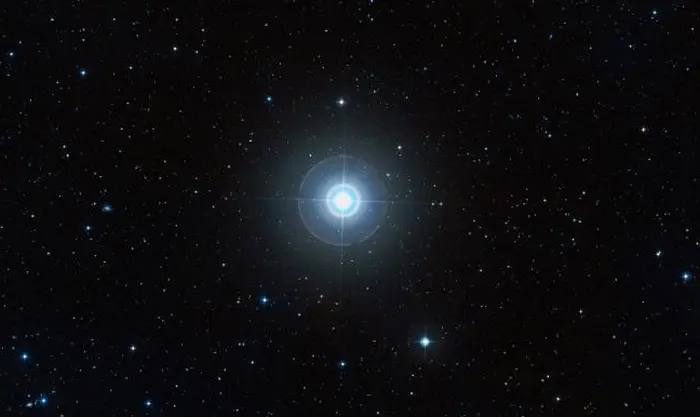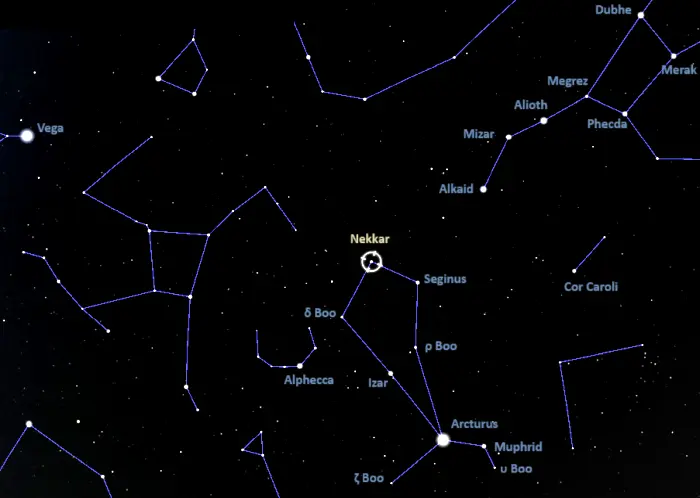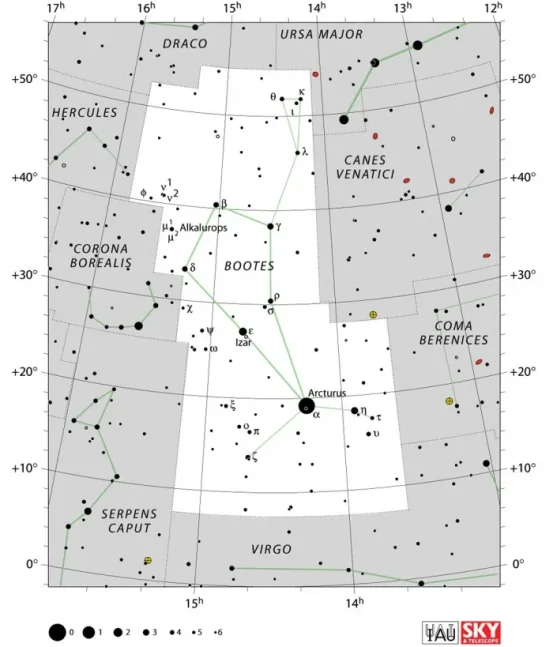Nekkar, Beta Boötis (β Boo), is a yellow giant star located 235 light-years away in the constellation Boötes (the Herdsman). With an apparent magnitude of 3.488, it is the sixth brightest star in the constellation. The evolved star marks the head of the celestial Herdsman. It is part of the Kite, a relatively bright asterism that dominates the Boötes constellation.
Star type
Nekkar is an evolved yellow giant star of the spectral type G8IIIa Fe-0.5. The “a” in the spectral class indicates that the star is slightly more luminous than other giants in this class. The suffix “Fe-0.5” indicates that spectral lines of iron are slightly weaker than expected.
Beta Boötis has a mass of 3.23 solar masses. As it evolved away from the main sequence, it grew to a size of 18.44 solar radii. The star’s radius was derived from the measurement of its angular diameter with the Navy Precision Optical Interferometer (NPOI) in 2018.
With an effective temperature of 4,997 kelvin, Nekkar is 188 times more luminous than the Sun. It has an estimated age of around 320 million years. It is approaching the solar system with a radial velocity of -18.35 km/s.
With a projected rotational velocity of around 4.1 km/s, Nekkar takes roughly 200 days to complete a rotation. The star’s pole is inclined about 28 degrees to the plane of the sky.

Nekkar (Beta Boötis), image credit: ESO/Digitized Sky Survey 2 (CC BY 4.0)
Facts
Nekkar marks the top of the Kite, a large asterism that takes up most of the constellation Boötes. The Kite is formed by Nekkar with the bright Arcturus (Alpha Boötis), Izar (Epsilon Boötis), Delta Boötis, Seginus (Gamma Boötis), Rho Boötis, Muphrid (Eta Boötis), Upsilon and Zeta Boötis. The main body of the Kite appears in the area between Arcturus, the Big Dipper’s handle, and the Keystone asterism in Hercules. Eta, Upsilon and Zeta Boötis mark the Kite’s tail and tether.

The Kite asterism, image: Stellarium
Nekkar’s brightness is dimmed by 0.06 magnitudes by intervening dust and gas. Without extinction, it would be equally bright as its Kite neighbour Princeps (Delta Boötis).
Nekkar is classified as a flare star, a variable star that sometimes dramatically increases in brightness for very short periods due to stellar flares. An X-ray flare from the system was detected by the ROSAT satellite in 1993. It released 1.7 x 1032 erg of energy. The flaring activity may be explained by the presence of an undetected red dwarf companion.
Nekkar is a mild barium star, which may indicate that it has a white dwarf companion. Barium stars are thought to be the result of mass transfer in a close binary system, where the more massive companion evolves into a red giant faster and pollutes the surface layers of the other star when it loses its gaseous envelope before becoming a white dwarf.
In old Arabic astronomy, Nekkar formed an asterism known as Al Dhi’bah, the Female Wolves (or Hyenas), with Seginus (Gamma Boötis), Princeps (Delta Boötis) and Alkalurops (Mu Boötis). A similar asterism representing two wolves or hyenas existed in the constellation Draco and was formed by Aldhibah (Zeta Draconis) and Athebyne (Eta Draconis).
In traditional Chinese astronomy, Nekkar was one of the stars added to the Seven Excellencies (七公) asterism, also formed by 42 Herculis, Tau Herculis, Phi Herculis, Chi Herculis, Nu1 Boötis, Alkalurops (Mu Boötis), and Delta Boötis. The asterism was part of the Heavenly Market Enclosure, which represented the Emperor’s Realm.
Name
The name Nekkar (pronunciation: /ˈnɛkɑːr/) comes from the Arabic word for the constellation Boötes, Al Baḳḳār (meaning the Herdsman or the Ox Driver). It was sometimes also spelled Nakkar.
The International Astronomical Union’s (IAU) Working Group on Star Names (WGSN) formally approved the name on August 21, 2016.
Location
Nekkar lies in the northern portion of Boötes and is the northernmost star in the Kite asterism. It appears in the region between the Big Dipper’s handle and the semi-circle of stars that form the main constellation figure of the Northern Crown (Corona Borealis). The top part of the Kite can be found between Alkaid at the tip of the Great Bear’s tail and Alphecca, the star that represents the jewel in the Northern Crown.
At declination 40° 23’, Nekkar never rises for observers south of the latitude 49-50° S.

The location of Nekkar (Beta Boötis), image: Stellarium
Constellation
Nekkar is located in the northern constellation of Boötes. It appears close to the celestial Herdsman’s left ear.
Boötes is one of the ancient constellations listed by the Greco-Roman astronomer Claudius Ptolemy in his Almagest in the 2nd century CE. It is one of the oldest constellations in the sky, first mentioned by name in Homer’s Odyssey.
Boötes is the 13th largest of the 88 constellations. It occupies an area of 907 square degrees. It is best known for being home to Arcturus (Alpha Boötis), the brightest star in the northern celestial hemisphere and fourth brightest star in the sky. The orange giant star has an apparent magnitude of -0.05 and lies 36.7 light years away.
Other notable stars in the constellation include the binary systems Izar (Epsilon Boötis), Seginus (Gamma Boötis), Delta Boötis and Alkalurops (Mu Boötis), the triple star Zeta Boötis, the quadruple star system Xi Boötis, the yellow subgiant Muphrid (Eta Boötis), and the orange giants Upsilon and Rho Boötis.

Boötes constellation map by IAU and Sky&Telescope magazine (Roger Sinnott & Rick Fienberg) (CC BY 3.0)
Deep sky objects in Boötes include the globular cluster NGC 5466, the lenticular galaxy NGC 5548, the Teacup Galaxy, and the spiral galaxies NGC 5676 and NGC 5248.
The best time of the year to watch the stars and deep sky objects in Boötes is during the month of June, when the constellation appears high in the sky in the early evening.
The 10 brightest stars in Boötes are Arcturus (Alpha Boo, mag. -0.05), Izar (Epsilon Boo, mag. 2.37), Muphrid (Eta Boo, mag. 2.68), Seginus (Gamma Boo, mag. 3.03), Delta Boötis (mag. 3.482), Nekkar (Beta Boo, mag. 3.488), Rho Boötis (mag. 3.59), Zeta Boötis (mag. 3.78), Theta Boötis (mag. 4.02), and Upsilon Boötis (mag. 4.023).
Nekkar – Beta Boötis
| Spectral class | G8IIIa Fe-0.5 |
| Variable type | Flare star |
| U-B colour index | +0.75 |
| B-V colour index | +0.94 |
| Apparent magnitude | 3.488 |
| Absolute magnitude | -0.70 |
| Distance | 235 ± 2 light-years (72.1 ± 0.7 parsecs) |
| Parallax | 13.8780 ± 0.1310 mas |
| Radial velocity | −18.35 ± 0.21 km/s |
| Proper motion | RA: −40.708 ± 0.114 mas/yr |
| Dec.: −30.168 ± 0.148 mas/yr | |
| Mass | 3.23 ± 0.07 M☉ |
| Luminosity | 188 ± 10 L☉ |
| Radius | 18.44 ± 0.19 R☉ |
| Temperature | 4,997 K |
| Metallicity | -0.86 dex |
| Age | 320 ± 20 million years |
| Rotational velocity | 4.1 ± 1.0 km/s |
| Rotation | 200 ± 10 days |
| Surface gravity | 2.45 ± 0.03 cgs |
| Constellation | Boötes |
| Right ascension | 15h 01m 56.7623044453s |
| Declination | +40° 23′ 26.046853660″ |
| Names and designations | Nekkar, Nakkar, Merez, Meres, Merets, Beta Boötis, Beta Boo, β Boötis, β Boo, 42 Boötis, 42 Boo, HD 133208, HR 5602, HIP 73555, SAO 45337, FK5 555, BD+40°2840, AG+40 1433, PPM 54491, GC 20226, GCRV 8706, NSV 6898, PLX 3399.00, JP11 2565, SKY# 27274, N30 3392, GEN# +1.00133208, GSC 03047-01258, PMC 90-93 393, 1RXS J150157.4+402327, RAFGL 1748, ROT 2140, IRC +40263, UBV 13041, UBV M 20520, WEB 12582, IRAS 15000+4035, 2MASS J15015676+4023259, TD1 17908, TIC 262880505, TYC 3047-1258-1, Gaia DR2 1296713990315380736, Gaia DR3 1296713990316692096, AAVSO 1458+40 |